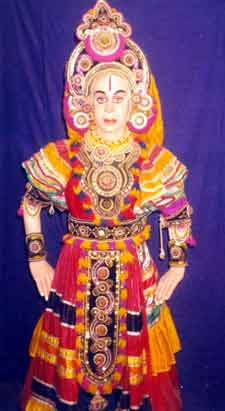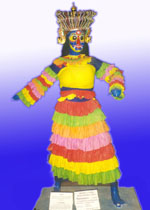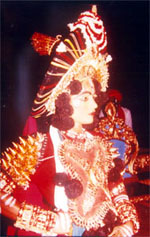 Yakshagana is believed to have a history of one thousand years. Yakshagana is believed to have represented a specific type of music of the 'yakhas'. Yaksha is the name of certain demi-gods attending on 'Kubera'- the god of wealth in the Hindu mythology. 'Gaana' means song. By combining the meaning, the term Yakshagana might mean the 'song of Yakshas'.
Yakshagana is believed to have a history of one thousand years. Yakshagana is believed to have represented a specific type of music of the 'yakhas'. Yaksha is the name of certain demi-gods attending on 'Kubera'- the god of wealth in the Hindu mythology. 'Gaana' means song. By combining the meaning, the term Yakshagana might mean the 'song of Yakshas'.
Of the 20 districts in Karnataka, Yakshagana has established its firm roots in the districts of Dakshina Kannada, Uttara Kannada, Dharwad, Mysore and Hassan. Based on its technique of presentation, Yakshagana has been broadly classified into 'Mudalapaya' (the custom of the east) and 'Paduvalapaya' (the custom of the west). Popularly known as 'Bayalata' or 'Aata', Mudalapaya is widely practiced in places like Tumkur, Bangalore, Kolar, Mandya, Mysore, Hassan, Chitradurga, Bellary, Dharwad, Bijapur, Gulbarga, Raichur, Bidar and Belgaum. While Yakshagana of North Karnataka has assumed varied forms like 'Sannata', 'Doddata', 'Krishna Parijatha' and 'Dasarata'. The form of Paduvalapaya' popular extensively in Uttara and Dakshina Kannad districts has been further divided into 'Thenku Tittu' (south) and 'Badagu Tittu' (north). Paduvalapaya is practiced in places like Karki, Keladi, Ikkeri, Sagar, Kolluru, Maranakatt, Sankuru, Coondapur, Kotesvara, Kota, Udupi, Dharmasthala, Mangalore, Brahmavara, Suratkal and Saligrama.
The Epics of Ramayana and Mahabharata offer extensive material for Yakshagana Prasangas (topic). The literature is presented both in verse and prose and the former is interpreted in simple prose and dialogues. The show begins with an announcement of Yakshagana by beating the 'Chande', in important places of the village.
Yakshagana is performed in a rectangular stage built with four wooden poles installed on four corners and covered by mats of palm leaves on the top. Away from the backstage is a small place called 'Chowki', the greenroom for the artistes. The audience sits on all the three sides of the platform and a curtain covers only the back stage.
 The life force of Yakshagana is the Bhagavata, the chief narrator of the story, in the verse form. Bhagavata also conducts light hearted conversation with the 'Vidushaka'- the jester. The dialogues between these two characters is very amusing and the Bhagavata ably supports the Vidushaka in carrying out extempore dialogues.
The life force of Yakshagana is the Bhagavata, the chief narrator of the story, in the verse form. Bhagavata also conducts light hearted conversation with the 'Vidushaka'- the jester. The dialogues between these two characters is very amusing and the Bhagavata ably supports the Vidushaka in carrying out extempore dialogues.
Music is the essence of Yakshagana and the narration is in verse form. It is the songs and poems which transmit the story and the songs are invariably sung by the Bhagavata. The music in Yakshagana is excellent and it seems to have been woven into Yakshagana with commendable background knowledge of its costuming and make up of the characters. Prose in Yakshagana is in the form of dialogues. The songs are sung by the Bhagavata at a very high pith and hence is considered as a distinct style of music. The rhythm that dictates the body movements, footwork and the performance actually flows from the musical instruments. In Paduvalapaya, 'Chande' (a cylindrical percussion drum beaten with two thin sticks) is the vigorous instruments and the beats of the Chande are symbolic of valour and prowess. Regional differences allow the use of other instruments like gong and cymbals. In Mudalapaya, the chief instrument is Mukhaveena (flute like wind instrument, a form of Nadaswara, a kind of musical pipe). Percussion instruments like the 'Maddale' and the 'Mrudanga' lend musical support. The latest trend is to use harmonium.
Performance
The entire Yakshagana performance rests on foot work, body movements, gestures and facial expressions. The rhythmic movements are the yardstick to feel the pulse of Yakshagana. Devoid of gentle movements, the dancing pattern in Yakshagana consists of squatting and jumping requiring quick body movements. During the battle sequences, the tempo of the dance is swift and intense and the pattern varies from one character to another. The performers donning a heavy costume jump high in the air and reel vigorously without losing physical balance and rhythm. The dancing spectacle of demon characters like 'Athikaya', 'Indrajithu' or 'Shurpanakhi' is breath-taking. The gestures, movements and footwork visually aid the comprehension of play. It is delightful to observe that no artiste over steps his role by resorting to long speeches. He performs with utmost dignity befitting the role.
The splendour of Yakshagana lies with the unusual costumes and make-up of the artistes. The smooth flow of heavy and gorgeous costumes testify to the stimulating power of this audiovisual medium.
The facial make up varies from simple to intricate designs depending upon the roles they play. Motif on the face varies for hero, demon and female characters. Demonical make-up is heavy with artificial eyelids and white dots are liberally applied to portray the ferocious and violent nature of the demons.
The traditional costume consists of a dhoti, a pyjama, a jacket and a loose gown. Depending upon the characters, they increase the girth of the body with sheets of colorful cloth and sarees tied around. In Yakshagana, it is customary for males to perform even the role of females.
Ornaments consists of 'Bhujakeerthi' worn for the elbow and looks like colourful shining wings. Its surface is plain in 'Mudalapaya' and it is rough, thorn-like in Paduvalapaya. Besides the heavy armlets and anklets, intricately designed 'Edehara' (chest ornament made of wood and pasted with paper and glass pieces) and 'Veeragase' (a piece of designed ornament tied around and flowing beneath the waist) are the other ornaments worn by the artistes.
 Headgears have a wide array of crowns. The selection of the headgear commensurate with the role represented by the artistes. The less important characters wear simple turbans of cloth. 'Mundasu' is a heavily set headgear, which gives a rich look to the character. It is broader in the middle which tapers as it proceeds upwards and appears like a lotus leaf. Since the Mundasu is heavy, it requires talent and prowess to wear it and dance.
Headgears have a wide array of crowns. The selection of the headgear commensurate with the role represented by the artistes. The less important characters wear simple turbans of cloth. 'Mundasu' is a heavily set headgear, which gives a rich look to the character. It is broader in the middle which tapers as it proceeds upwards and appears like a lotus leaf. Since the Mundasu is heavy, it requires talent and prowess to wear it and dance.
Female costuming is simple and matches with the contemporary style but does not match with the psychedelic and gorgeous costumes of male roles.
this is what YAKSHAGANA.....
its nice
ReplyDelete